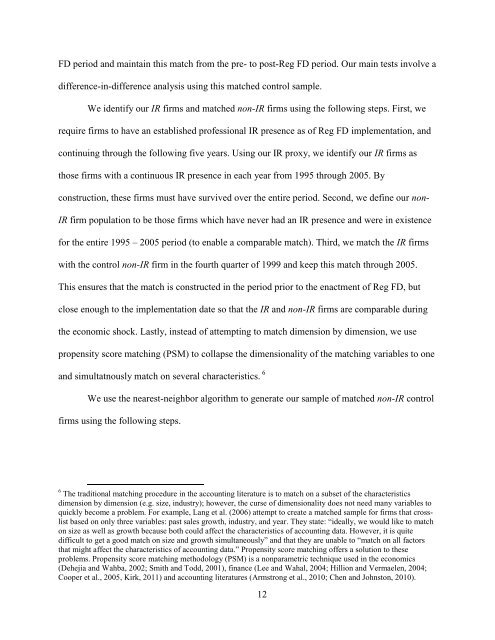Investor Relations and Regulation FD
Investor Relations and Regulation FD
Investor Relations and Regulation FD
You also want an ePaper? Increase the reach of your titles
YUMPU automatically turns print PDFs into web optimized ePapers that Google loves.
<strong>FD</strong> period <strong>and</strong> maintain this match from the pre- to post-Reg <strong>FD</strong> period. Our main tests involve a<br />
difference-in-difference analysis using this matched control sample.<br />
We identify our IR firms <strong>and</strong> matched non-IR firms using the following steps. First, we<br />
require firms to have an established professional IR presence as of Reg <strong>FD</strong> implementation, <strong>and</strong><br />
continuing through the following five years. Using our IR proxy, we identify our IR firms as<br />
those firms with a continuous IR presence in each year from 1995 through 2005. By<br />
construction, these firms must have survived over the entire period. Second, we define our non-<br />
IR firm population to be those firms which have never had an IR presence <strong>and</strong> were in existence<br />
for the entire 1995 – 2005 period (to enable a comparable match). Third, we match the IR firms<br />
with the control non-IR firm in the fourth quarter of 1999 <strong>and</strong> keep this match through 2005.<br />
This ensures that the match is constructed in the period prior to the enactment of Reg <strong>FD</strong>, but<br />
close enough to the implementation date so that the IR <strong>and</strong> non-IR firms are comparable during<br />
the economic shock. Lastly, instead of attempting to match dimension by dimension, we use<br />
propensity score matching (PSM) to collapse the dimensionality of the matching variables to one<br />
<strong>and</strong> simultatnously match on several characteristics. 6<br />
We use the nearest-neighbor algorithm to generate our sample of matched non-IR control<br />
firms using the following steps.<br />
6 The traditional matching procedure in the accounting literature is to match on a subset of the characteristics<br />
dimension by dimension (e.g. size, industry); however, the curse of dimensionality does not need many variables to<br />
quickly become a problem. For example, Lang et al. (2006) attempt to create a matched sample for firms that crosslist<br />
based on only three variables: past sales growth, industry, <strong>and</strong> year. They state: “ideally, we would like to match<br />
on size as well as growth because both could affect the characteristics of accounting data. However, it is quite<br />
difficult to get a good match on size <strong>and</strong> growth simultaneously” <strong>and</strong> that they are unable to “match on all factors<br />
that might affect the characteristics of accounting data.” Propensity score matching offers a solution to these<br />
problems. Propensity score matching methodology (PSM) is a nonparametric technique used in the economics<br />
(Dehejia <strong>and</strong> Wahba, 2002; Smith <strong>and</strong> Todd, 2001), finance (Lee <strong>and</strong> Wahal, 2004; Hillion <strong>and</strong> Vermaelen, 2004;<br />
Cooper et al., 2005, Kirk, 2011) <strong>and</strong> accounting literatures (Armstrong et al., 2010; Chen <strong>and</strong> Johnston, 2010).<br />
12
















